ISSUES,INSIGHTS AND COLOURFUL MOMENTS-FROM THE DESK OF AN ENGLISH AUTHOR.
ISSUES,INSIGHTS AND COLOURFUL MOMENTS-FROM THE DESK OF AN ENGLISH AUTHOR.
This is the right time of the year for reflection. Having braved the freezing grip of winter winds and managed to stretch a faithful leg to the local church, it’s time for a different sort of meditation. Satiated with a surfeit of wine, minced pies, and all those extra glories festive tables are given to bestow, with gratified contentment, and perhaps toes to a log fire, you can begin to let the mind wander from your Christmas cheer to Summer, bringing to your imagination those as yet unexplored parts of our continent. In deference to the fact that this celebrates and represents a Christian festival, one’s thoughts may turn to Italy.
One of the inconvenient aspects of touring by automobile is the daily aggravation of discovering a suitable lodging before the twilight fades altogether. No doubt the experienced adventurer will have their itinerary signed and sealed before they set out. Most will not. Those that do, may well have the advantage of discovering where it’s actually worth going! If you’re a pot luck sort of person, then this blog is probably not for you. So, if you’re the type who plans ahead and desires an interesting destination somewhere in Italy, take your pin out and stick it randomly in Tuscany! With a modicum of luck, you may find yourself heading for one of the most ancient and mysterious cities in Italy.
Volterra lies at approximately one thousand seven hundred feet above sea level - windy it can certainly be - but from its towering height one can see some of the most magnificent views in Tuscany. To the south-west you may just get a peep of the island of Corsica, but more spectacularly, to the north, a 180° panoramic view of the great Apennine chain of mountains that run down the length of Italy. It is a rare, truly ancient medieval city, built on even more venerable Etruscan foundations and retaining all of its later architectural integrity virtually untouched.
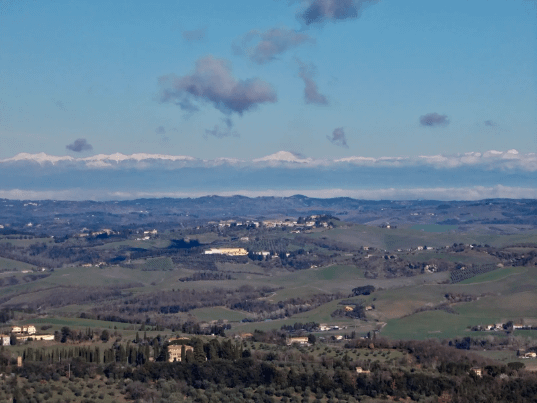
Image by Author
To access Volterra you will have either twisted your way from the west through an open, ever steepening hill side, with its spectacular views of the city, or an equally steep road from the north, through olive groves and deep valleys, with snap peeps of the city, high on the distant summit. On the other hand, not chancing to fate, you may have headed down the A1 from Florence to Siena, turning off the motorway at Colle di Val d’Elsa to travel a less inspiring route, with hardly a peep at your destination until the drive is almost over. However, once having passed under two old railway bridges you will become aware of a massive Mediaeval Fortress built on the order of the Duke of Athens in 1342 and extended in 1474 by Lorenzo the Magnificent. Resting on the city’s periphery it indicates your arrival. More interesting at this moment perhaps, is that the Catholic Church, given its lack of those seeking monastic seclusion, has sensibly seen fit to allow a number of its neglected monasteries and convents to be turned into hotels or guest houses. Therefore, take an attentive note. Having passed under the bridges, you will almost immediately reach two roads on the right. Both will take you to our suggested destination - though, more appropriately, to either the front or back door of the expected lodgings. This is somewhat eccentric, because in this case, the back door is the external historical architectural highlight of the attached convent and church complex. Specifically, the first road will take you down a twisty wooded lane to the church and convents back door, the second, to the city’s hospital! And there’s the twist. If you’re feeling moderately conservative, I would recommend you settle for the hospital road, leaving the church road for later scrutiny.
This second road which leads directly to the hotel, commences with an avenue of trees. Passing a left turn, and an immediate large building, the road emerges into a single line of trees on the left that conveniently continue to the expected destination. On the right one passes various large buildings - the first being a rather grand architecturally interesting stuccoed and faux stone construction, then ultimately, a large square forlorn windowless building that used to be the hospitals ‘once upon a time’ theatre and cinema. “Right on” as we Cornish might say! Beyond, the road begins to rise with a stone wall on the right. At the top of this road before it takes a sharp curve to the left, - Pause - turn right, where abruptly on the right you will find an entrance to the ‘’Chiostro Delle Monache’’ hotel’s reception and ample car parking.
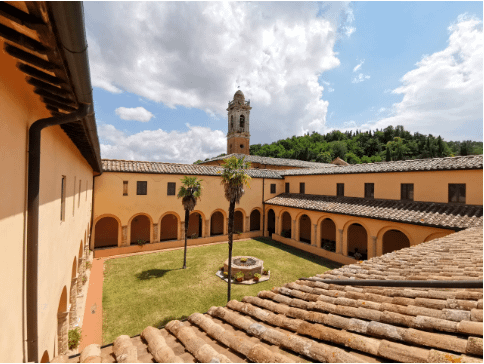
Photo courtesy of Enrico Sabatini @ NEROGOTICO
In terms of hospitality, nothing has changed. In centuries past, if travelers, pilgrims, or otherwise, sought shelter at an ecclesiastical retreat, they would certainly have been ushered in. The monks may now have gone, but a cordial welcome continues, where guests are still going to find a most genuine and hospitable reception amid an atmospheric, classically refurbished ex- convent. Today, with the blessing of the Church authorities, agreements with the town council, and the entrepreneurial enthusiasm of a local business family, the convent has been brought back from a threatened decline to benefit the truly Italian philosophy of affability and courtesy. This attitude continues the tradition of the convent’s principles. Nonetheless, consequently, the enterprise obviously required a new title as a commercial entity, as a result adopting ‘’Chiostro Delle Monache’’, as mentioned above.
(For the purpose of this article, as the convent locally continues to be referred to simply as San Girolamo, I will proceed by using that same reference.)
Confusingly, in English usage, a Convent refers to a community of Nuns, while historically it might also be used for Monks, especially the Mendicant orders, coined from the Latin word for begging - mendicus.
The Convent of San Girolamo, (active - 1445-1992.) in an area brimming with silence, is situated within a quiet pastoral backwater of Volterra. The convent came into existence during a particularly disturbed period for the city. The late fifteenth century saw the rise of Florence to the height of its hegemonic power, and Volterra was too important a city, given its control over important alum and salt quarries. An eventual benefit to this project was the patronage of the all-powerful Medici family.
First mooted in 1424, when San Bernardino da Siena, was invited to give a public sermon in Volterra, the enthusiasm of the population, inspired the subsequent proposal for the creation of a church and convent. For several months this became initially bogged down in an argument over the position of the site, finally settling for the district of Velloso. Interestingly today, indicated by a fountain, ‘Fonte Velloso’, now sadly dry. It is recorded that the convent’s location was chosen as a site for being “sunny, wooded, with water, and on an existing ancient route just outside the city’s medieval walls”.
Originally titled the, ‘’ Convento di San Girolamo al Velloso’’, home to a Franciscan mendicant religious order, a community of begging friars surviving on charity in return for their good works. A new order, was created in 1895 out of four separately developed medieval groups, all originally following St Francis of Assisi, 1181/82 - 1226, each normally surviving on charity. Franciscan friars had a very tightly controlled area for collecting alms to avoid encroaching on each other’s boundaries. Though the monks were individually not allowed to gain from this practice, it did not apply to a collective, enabling some orders to gradually own extensive estates, income and thus, becoming too powerful. This state of affairs came to an end, when Pietro Leopoldo - Grand Duke of Tuscany, instigated property reforms. This included confiscating large swathes of lands and property from the monasteries, ostensibly to enhance the rights of the peasantry in an effort to increase the production of food for an expanding populace. (Benito Mussolini was later to have much the same idea, finally being ushered in by the Italian Communist Party after the 1939/45 Second World War.) How this effected San Girolamo is not strictly recorded as apparently the order owned little rural estate, only sufficient for their own needs.
However, to continue. With the support and prestige of Cosimo di Giovanni de’ Medici, known as ‘il Vecchio’, the impetus to complete the project was fulfilled. Later, patronage continued in the form of financial charity from local noble families, to provide essential necessities such as maintenance, mattresses, etcetera. As an aside, these bedding items were traditionally made of sheep’s wool. We well remember some neighbours, and many others locally, continued this tradition almost up until the present day. Though not exactly popular with the younger generation, as the mattress’s wool padding was removed, then combed and cleaned by hand annually. Quite an undertaking! The building of the church and convent, therefore took place on the cusp of an architectural change from the Gothic to the Renaissance. The Italian transition took a different path from that of Europe in general by looking back to historical Roman influences for inspiration, reinterpreting the style and character of a lost age. The attractive open gallery on a building being one such aspect. San Girolamo, therefore, is a very early example of the Renaissance reflecting this architectural change.
Like all historical buildings in Italy, you will find interesting narratives behind the façade, and the attached San Girolamo al Velloso church. During the period when our subject was undertaken, the Catholic Church was the most powerful organisation on earth, with the Pope not beyond removing a rebellious King! That being the case, they were particularly attentive to the construction of religious buildings as a symbol of the church’s eminence, lavishing even the more obscure dioceses with famous architects and artists to create them. The actual architect of the San Girolamo complex remains controversial, apparently considered to have been either Michelozzo Michelozzi, sometimes known as the ‘Medici Architect’, or his one-time master, Lorenzo Ghiberti, sculptor of the famous bronze Baptistry doors of Florence Cathedral. Whichever architect it was, he chose to give the interior of the church ribbed cross vaults on hanging capitals, and a novel portico entrance, with obligatory columns reflecting the Roman inspiration. Something of an interesting surprise is the unusual addition of incorporating two external side chapels, the altars holding beautiful glazed terracotta statues (1501), by Giovanni Della Robbia.
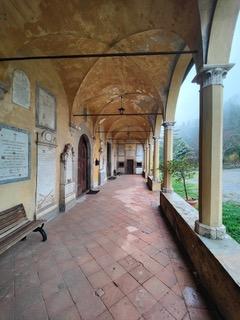
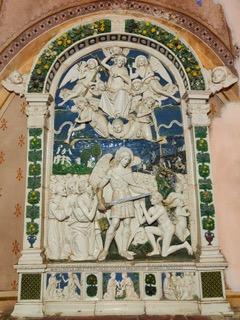
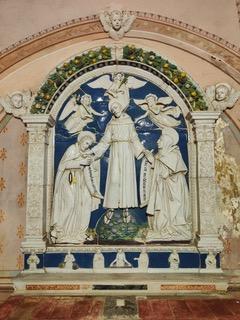
Photos courtesy of Enrico Sabatini @ NEROGOTICO
The interior of the church, much altered during its life, was initially completed in 1455 and finally returned to its original medieval Franciscan appearance during a restoration carried out in 1952/55, exactly five hundred years later.
Perhaps a little enigmatic is the convent itself. Externally sombre in style, given the fame of the architect, it is nevertheless an immaculately constructed layout, lying behind and to the side of the church. This large complex area now forms the current hotel. However, some indication of its architectural integrity, relevant to both parts - church and convent - is the highly decorative brick work corbel below the roofs. Historically, little was set down of the friars’ original period of its habitation, though, for example in 1650, it was recorded that there were 18 rooms/cells for resident friars with 14 guest rooms/offices, though the former must have at some time been considerably more substantial given its extensive holdings.
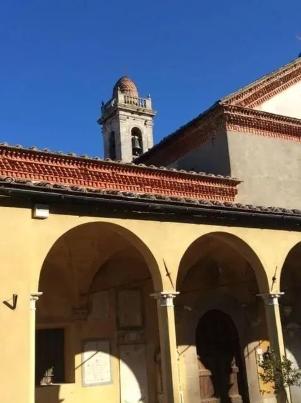
Image by Author
This large complex area now forms the present hotel, and it provides, as one visitor put it: “An area where the air is as cool and fresh as chastity.” A little poetic perhaps? Its location can certainly be said to have an exceptional tranquillity, and the monastery is a sufficient distance from main roads to ensure an idyllic and sequestered environment. Albeit, the city itself being enclosed, has found it necessary to restrict most of its visitor’s vehicle parking to the north west of the city. Moreover, the hotel can also be said to provide a sort of calm quiescence, an escape from the hustle and bustle of the modern world. There is a beguiling stillness, an impressively soothing hush pervading the corridors that filters through to the open gallery of a large cloister, where once the friars walked in sheltered meditation. Now, in contemporary times, during the summer months, perhaps whilst sipping a refreshing aperitivo, can occasionally be heard the strains of live Classical or perhaps, Tuscan music. In addition, throughout the year, Art Exhibitions are displayed in some corridors. The whole further enhancing an aura of congenial well-being. The enchanting inner cloister, is now atmospherically planted in accordance with a monastic ambience. If sitting there, from time to time, you may be fortunate enough to view a tortoise taking a leisurely meander amongst the foliage. The whole has a hushed calmness that is surely inherited from the spiritual nature of its original inhabitants.

Photo courtesy of Enrico Sabatini @ NEROGOTICO

Photo courtesy of Enrico Sabatini @ NEROGOTICO
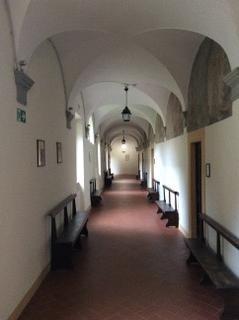
Image by Author

Image by Author
Traditionally, both Volterra’s citizens and other visitors, are welcomed when they chance to drop by for a coffee or refreshments, all helping to generate a further comfortable and homely Italian atmosphere. Dining, for which booking becomes necessary, is taken in the original refectory with its celebrated frescoed lunettes. All of this, far removed from those Globalist Technocrats!
Photo courtesy of Enrico Sabatini @ NEROGOTICO
But history is too often only the bare bones of a long and vigorous life. As a more recent example, San Girolamo was to play its part in the Second World War as the allied armies swept their way relentlessly northwards through a stubborn wall of German occupation. In 1976 an account told the story of two young teenage girls of Jewish descent through their mother. The family, then living in the countryside, became aware that the nearby gestapo was about to confiscate their house for billeting. Cognisant of the danger to them racially they escaped at night to Volterra where these circumstances forced their mother to find relative safety in the Psychiatric hospital, while the father, left the two girls with nuns associated with the same hospital, before seeking inconspicuous protection for himself. Just a few days later, learning of their Jewish background, these nuns became terrified, and requested they leave to find protection elsewhere. One can only imagine the terror these two young girls must have felt, but they remembered their father referring to San Girolamo Convent, which they knew to be nearby. After pounding the door in anguish, one of the three friars remaining in the convent, answered. In desperation, they hastily told of their plight and despite the proscription of women entering the monastery, he secreted them away within its walls as boys, away from the ever-watchful eyes of the German SS. They were not to be alone for long as the war finally reached Volterra. For nine days American planes, in preparation for the allies’ advance, continuously bombed the city, forcing frightened citizens to seek shelter outside the walls. Thus, San Girolamo became a refuge for many more people where the three remaining resident friars sought to comfort and reassure them.
If the walls of San Girolamo could speak, what tales they would have to tell of its five-hundred-year history!
As a suggestion, while firmly ensconced in San Girolamo with an enlightened awareness of its historical context, you may like to explore something of the life of those souls who made Our Lord their vocation. Given the vagaries of time, not all will lead you to grand Christian edifices, but all will grant you an interesting awareness and deeper understanding of religious movements, their environmental, architectural and social development. These formed the basis of the spiritual and material world of our Western culture. Therefore, the following inventory may be enlightening: Volterra - a city said to be already old seven hundred years before the fall of Troy - has had, since the collapse of the Roman civilization, a numerous varied selection of celibate communities seeking seclusion from the world - not all of them Mendicant, who by their nature, were very much part of the local society. One interesting fact, not readily appreciated, and responsible for the great number of convents housing women, was the necessity of providing a dowery before marriage. As poverty was rife in Medieval Europe countless women without such largesse were forced to find protection within the church.
Unlike San Girolamo, and with the exception of the Abbazia Camaldolese, 11th - 19th century, and the Convent dei Cappuccini, 14th century, most of these fraternities could be found within the walls of the ancient city. During the Roman period, after the death of St. Peter the Apostle, the creation of the First Pope took place - Saint Lino of Volterra. (Often referred to as the second Pope, but it should be assiduously noted that St Peter was an Apostle not a Pope!). Lino was born to the illustrious family de’Mauri in the year 18 AD at the family home where now stands the Church of San Lino, once also a monastery, and occupied by Nuns 1480 - 1978. It is worth noting that these Nuns were famous for embroidery, which included ecclesiastical robes, teaching, taking in abandoned innocent babies, along-side good works for needy members of society. The church of San Lino itself, with its austere exterior, belies its magnificent fresco vaulted ceiling with framed lunettes, including twelve stories depicted by the artist, Cosimo Daddi (16thcentury), coexisting with other exquisite works of art.
A few footsteps away is the Monastero del Dalmazio, 15th - 18th century, also once occupied by Nuns. Now only occasionally open to the public.
Passing on your way to the Etruscan Museum, along the Via Don Minzoni, you will first reach Sant’Agostino, a large church, 16th - 19th century, now the very splendid Diocesan Museum of the Sacred Heart, housing a varied and exceptionally interesting collection of liturgical objects both rare, varied, and informative.
Technically, inside the historical city (Etruscan walls) but outside the inner medieval walls, can be found, in the Borgo Santa Stefano, the magnificent Monastero Santa Chiara, 16th century, by the Florentine architect Giulio Parigi, presently a secluded rest home for the elderly. Originally, the Volterra order of Santa Chiara was founded in a stone-built countryside residence, thought to have been a farmhouse of some substance. In the via Porta Diana at the junction with the via delle Cetine, set within the façade of a private building’s side wall facing the road, can still be seen the only remaining evidence of the original convent, being a small image in glazed majolica of the Madonna of Santa Chiara recording the convents 16th century historical origin.

Image by Author
Leaving Volterra along the Via Mazzini, at the first acute corner, turn left, entering the Via dei Cappuccini leading you past the football stadium and out into the countryside. At approximately half a mile you will come across the abandoned, gaunt, and sadly derelict, Convento dei Cappuccini. It is worth the short trip just to ponder on societies disgraceful attitude and neglect of its patrimony, many of the inner walls covered in lewd graffiti!
Finally, a half kilometre along the road to Pisa, on the Via di Mandringa, stands the significant 11th century Romanesque Benedictine Abbazia Camaldolese, 1030 - 1861. Open during Winter months at week-ends, but during summer months more frequently. The interior reveals, in the refectory, its series of magnificent restored frescoes painted by Donato Mascagni, depicting stories of the city’s patron saints, San Giusto and Clemente, alongside other internal rooms, which allow one to have a better inkling of the monastic life. Architecturally, the monastery is built round a very large impressive well, gathering water from its roof and surrounded by the cloisters. One wall, adjacent to the well, marks how time was originally calculated by the sun, likely used to bring order to their lives.
On second thoughts, discard the pin and the map - why not just go to Volterra?
Buonissimi Auguri per il nuovo anno 2024.
Buon Viaggio e Buona Vacanza,
wherever your legs or wheels should take you in the future.
Chiostro Delle Monache - direct link in English.
https://www.chiostrodellemonache.com/?lang=en